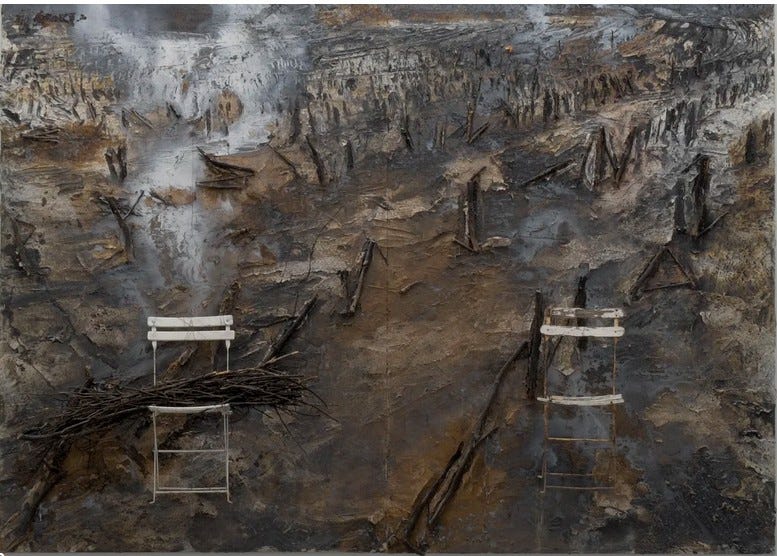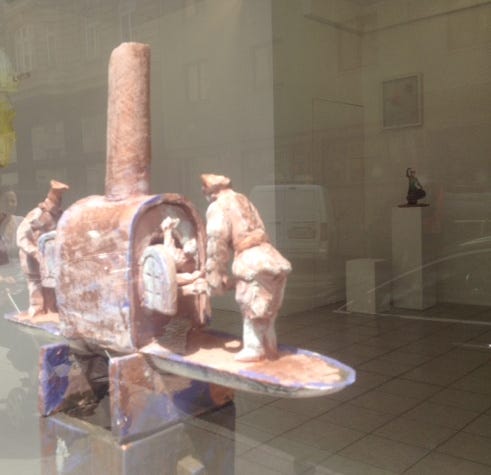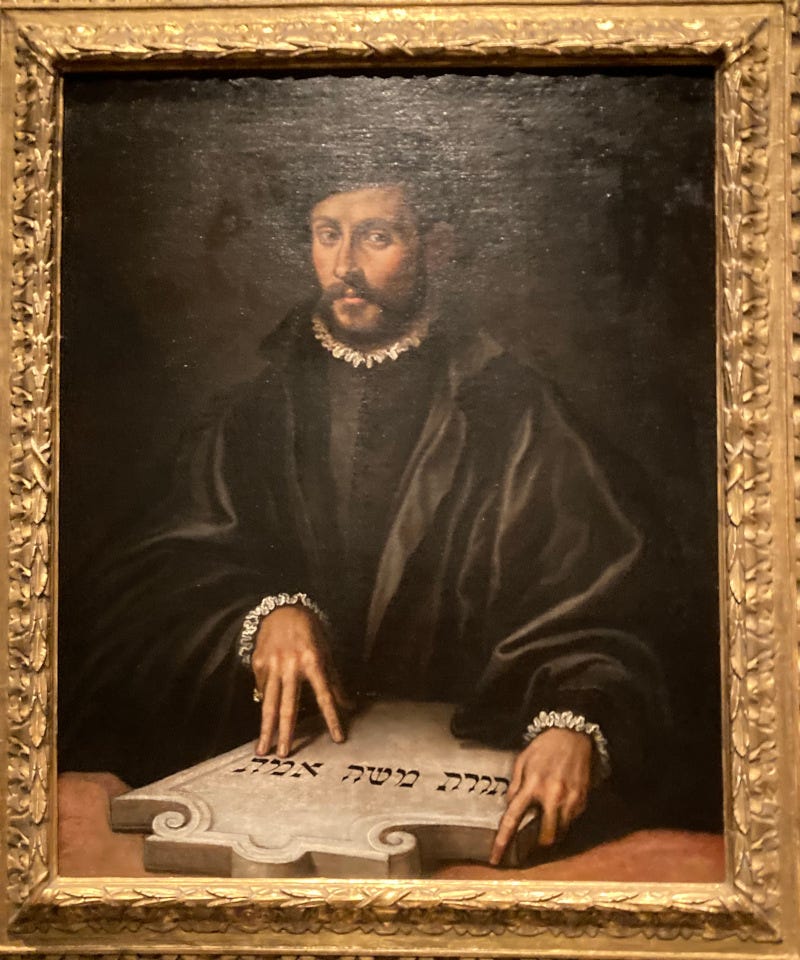[Warning: Graphic image.]
I've known dozens like Yaron Lischinsky, the Israeli embassy staffer murdered in Washington. I’ve met hundreds in the seven years I lived in Vienna, hundreds who could only bear their Christian identity by identifying or performing as Jews.
Lischinsky was such a German. Born to a Jewish father and a Christian mother, he pursued “being Jewish” by volunteering for the Israeli Defense Forces and working for the Israeli Embassy in Washington. He planned to marry his Jewish girlfriend in Jerusalem; perhaps he dreamed of producing a progeny of “real” Jews: Jews by the mother, according to traditional law. Lischinsky spent his whole short life running from who he was, till it caught up with him.
“No one is German of his own free will,” says a Nazi character in Martin Walser’s play, The Rabbit Race, that magisterial sendup of German accommodationism.1 The correlative is, that anyone can be a Jew of his own free will—that being a Jew in a rule-bound society like Austria or Germany is the only available expression of free will. Judaism as a vocation. Max Weber would have loved it.
Unfortunately, in Germany and Austria there are few opportunities to be a Jew in the legal sense. To be legally Jewish you must belong to the Kultusgemeinde, the Government-sponsored Jewish Community with a State-granted monopoly on all things Jewish, following the Medieval tradition of corporate entities, still very much alive. Officially there are 10,000 Jews in Austria. Unofficially there may be a quarter million or more, non-practicing descendants of Jews who — wisely — maintain the old tradition of keeping your head down lest it be lopped off. To be a Jew in Germany or Austria today you must go by the rules laid down by the State, and the State has every incentive to narrow the definition of what makes a Jew. In the words of Karl Lueger, the mayor of Vienna who inspired Adolf Hitler, “I decide who is a Jew!” [I’ bestimm wer iz a Jud!] The State, by designating its Jews as the only valid Jews, can safely proclaim the abolition of antisemitism: how can there be antisemitism if there are no Jews?2
Despite this, in Austria and Germany there is a small, ephemeral population I call “White Jews,” Germans attempting to assume an identity that runs against their legally assigned identity. These are designated Christians who choose to function as Jews, ostentatiously wearing a Star of David or a knitted cap; affecting a weak spirituality. Some may even believe they’re reclaiming their hidden heritage as Jews.
I suspect Lischinsky was of another type— a type I got to know quite well in Vienna. Call them performers of anti-antisemitism. These are non-Jews whose social identity is centered around the pose of not being antisemites. They go off to a kibbutz as teenagers; they act as “allies.” They volunteer for the Israeli Defense Force. Extra points.
And, as was my case, they collect Jewish friends and colleagues. Jews in Vienna are a valuable investment, at once welcome and resented. You must never tell your Austrian friends and allies they’re not antisemites, because once that’s established you’re of no use to them. You must never say they’re antisemites either, obviously, and for the same reason. These are the conditions under which you’ll be allowed to live in Vienna as a Jew. These are the conditions that sooner or later bring the realization that you must leave; either that, or turn into another sad, aging Austrian Jew, quietly staring into his coffee.
In Germany and Austria, professing love is a profession. There’s plenty of money in grants and projects, since proving to the world (against all evidence) that we are not antisemites is a major cultural industry that’s heavily sponsored by the State because it serves the interests of the State to show the World it’s put its sordid past behind. The more progressive political and cultural elites promote these projects while the conservative elites and the man in the street resent them; but since there is very little ideological difference and a good deal of consanguinity among the various actors, the promotion and resentment come in a single package.
And the resentment’s toxic. In Vienna nearly all acts of anti-antisemitism come with a backlash of antisemitism. I have a memory of sitting with friends in a Viennese tavern on a Summer night. One friend was just back from curating the Austrian section of the museum at Auschwitz. Her partner, next to her, was loudly spewing hatred against the Jews.
Austrian and German anti-antisemitism is the flip side of Austrian and German antisemitism. Both are expressed as one, the one nestled in the other. You go to a gallery opening and the artist gives a speech explaining how this piece of polished wood is an homage to Sarah, age 12, murdered in Maidanek on such-and-such a date under such circumstances; said with a gleam in their eye. More so even if there’s a Jew in the audience.
Because it’s not about making reparations, it’s about controlling the narrative. And who would be more desperate than the sons and daughters of Nazis and their supporters? There are occasional efforts among Viennese Jews to take back their own narrative, say by holding commemorative ceremonies or demanding that Kristallnacht be observed. They’re usually ignored; only the radical Left shows up. Or, try to report to the authorities that the gallery on your block has in its window a quaint, almost childlike sculpture of Nazis shoveling people into ovens. You’ll get nowhere. The State is the authority, and the authorities make sure you know it.
According to the common narrative, antisemitism arises out of the irrational, rabid masses. In a bitter letter to his friend and colleague Theodor Adorno, Marx Horkheimer suggested that in reality it was the cultural and political administrators of a supposedly rational society that formed and propagated the mental, moral framework behind apparently irrational outbursts like antisemitism — this as part of Adorno and Horkheimer’s critique of Enlightenment liberalism. For Horkheimer, Adorno's social psychology that teases out the unconscious motives that purportedly drive the Authoritarian Personality was a waste of time:
“In reality, people live in structured, organized, integrated, and Gestalt-like groups. They don’t make decisions as individuals […] Therefore, the group is what must be influenced, the “group atmosphere” must be changed, the conditions under which the group makes its decisions must be manufactured. […] The change in atmosphere is achieved by training their leaders, who then train their sub-leaders, who then train their members.”3
Horkheimer’s insight fits the Austrian situation like a glove. It applies, first of all, to those coteries of clerics who, according to R. I. Moore, invented European antisemitism in the thirteenth century.4 The “Persecuting Society,” as Moore calls it, originated in the tightly organized systems of administration of the Early Gothic: the courts of law, the universities, the Church, all in competition with their Jewish counterparts. It’s the same inherited system in Vienna today, in the courts of law, among the sons of bourgeois lawyers and administrators who attend the University as their fathers and grandfathers did. The functions of the universities, the cultural circles, the liberal media today, is the same as in the 13th century, the social reproduction of traditional relations, in particular the relations of Gentile and Jew.
The antiantisemites of today are the children of the antisemites of yesterday (It’s called introjection). This guarantees that these relations will remain the same within the institutions themselves. The relations that are consciously intended to pose a cognitive framework for society also guide relations within the institutions themselves: at once overtly antiantisemitic and covertly antisemitic. The same apparatus that yesterday sent Jews to the stake can indifferently send “antisemites” to the stake today. Just as New Testament theology was constructed to compete and absorb the theology of the Old Testament, so, too, relations within the cultural apparatus of Vienna are at once competitive and parasitic—not on Jews themselves, but on the conception of the place of Jews in a Christian society. I once had to explain to a Gentile colleague the purpose of a temporary grave marker. A second Jewish scholar, far more competent than myself, agreed with my evaluation. The Gentile made a point of choosing an altogether different interpretation and publishing it, with a note dismissing both of us as “incorrect.” You have to be an academic to understand the malice.
And I’ve never worked at the Israel Embassy but I have enough experience of mainstream Jewish organizations to have a good idea of what it’s like. The social dynamics that were the unspoken condition of Yaron Lischinsky’s participation cannot be disentangled from the dynamics of inclusion and exclusion I myself experienced in Vienna and elsewhere, only in reverse, with the Gentile stuck in the role of outsider, an administrative Shabbos goy. Yaron’s sad death reminds me of the bombing outside a synagogue in Paris in 1980 in which four passers-by were killed; of the disgraceful comment by Raymond Barre, the French Prime Minister, that “innocent Frenchmen” had been killed instead of the intended Jewish congregants. Barre later raged that the negative reaction to his comment was the work of a “Jew lobby most closely tied to the Left” [« lobby juif le plus lié à la gauche »]. Antisemite, anti-antisemite, anti-anti-anti. ‘Round and ‘round and ‘round she goes.
In the end, I suspect, Yaron achieved his life ambition: to be a persecuted Jew. His innocent victimhood caught up with him. What a waste.
WOID XXIV-46
June 3, 2025
„Keiner ist freiwillig ein Deutscher.“ Martin Walser, Eiche und Angora. Eine deutsche Chronik [revised version] (Suhrkamp, 1963): p. 66.
Marin, Bernd, “A Post-Holocaust ‘Anti-Semitism without Anti-Semites’? Austria as a Case in Point,” Political Psychology, vol. 2, no. 2, (1980), esp. note 9, p. 70.
Max Horkheimer to Theodor Adorno, November 24, 1944; “Teaser: The Rapid Deactivation of the Subject (1944/45),” translated and edited by James Crane, https://substack.com/home/post/p-162498734 ; accessed May 26, 2025
R. I. Moore, The Formation of a Persecuting Society. Power and Deviance in Western Europe, 950-1250 (Blackwell, 1987).









provoking. thank you.
On the late side, I received this call for the Wiener Kongress zum jüdischen Anti-Zionismus (Jewish Anti-Zionist Congress) being held in Vienna this weekend:, June 14-15:
https://www.juedisch-antizionistisch.at/en
https://www.juedisch-antizionistisch.at
Their informed description of the conditions under which antisemitism, and that form of fake anti-antisemism masquerading as Zionism are allowed to flourish in Austria agrees with mine.